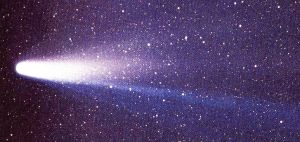Comet
A comet, or "shooting star," is a celestial body, usually composed of rock and ice. If a comet approaches close enough to a star, the increased heat causes it to shed mass, creating a "tail."
Comet nuclei range from a few hundred meters, to tens of kilometers across, and are composed of loose collections of ice, dust, and small rocky particles. If sufficiently bright, a comet may be seen from Earth without the aid of a telescope. Comets have been observed and recorded since ancient times, and have been given meaning by many cultures and religions. Comets usually have highly eccentric elliptical orbits, and have a wide range of orbital periods, ranging from several years to potentially several millions of years.
Comets are distinguished from asteroids by the presence of an extended, gravitationally unbound atmosphere surrounding their central nucleus. However, extinct comets that have passed close to the Sun many times have lost nearly all of their volatile ices and dust and may come to resemble small asteroids. The main difference between asteroids and comets is their composition. Asteroids are made up of metals and rocky material, whereas comets are made up of ice, dust and rocky material.
Halley's Comet
One of the best known comets in the Sol system is known as "Halley's Comet." Halley's Comet is arguably the most famous comet in Human history.
Known as a "periodic" comet, it returns to Earth's vicinity about every 75 years. Noted years include 1986, 2061, and 2134.
The comet, officially called "1P/Halley," is named after English astronomer Edmond Halley, who examined reports of a comet approaching Earth in 1531, 1607 and 1682.
He concluded that these three comets were actually the same comet returning over and over again, and predicted that it would return in 1758. Halley's calculations showed that at least some comets orbit the sun.
Fun Facts:
- During the 22nd century, many comets in the Sol system were diverted to Mars in order to benefit the Martian terraforming project.
At one point, fourteen comets were scheduled to impact with Mars in a thirty-month span, which made this mission of high importance.
- In 2151, the Earth starship Enterprise, NX-01 discovered the largest comet yet observed by Humans or Vulcans. It had a diameter of 82.6 kilometers or 51.3 miles.
It was named "Archer's Comet," in honor of the Enterprise's Captain, Jonathan Archer.
- The Enterprise D tracked a rogue comet through Sector 1156 in 2370. It ultimately proved to be a D'Arsay cultural archive, built over eighty-seven million years ago.
- In 2377, members of the USS Voyager undertook a mission to collect comet bio-matter so that The Doctor could create new medicines.
